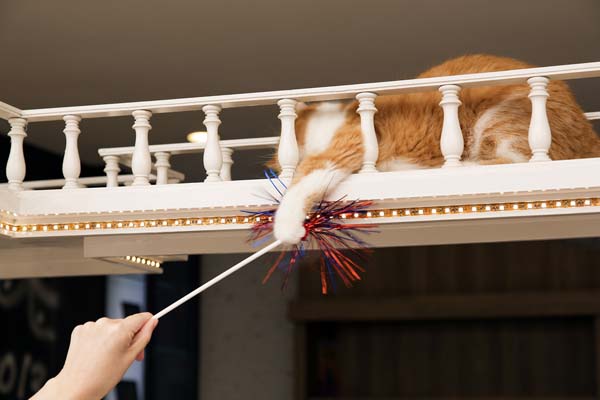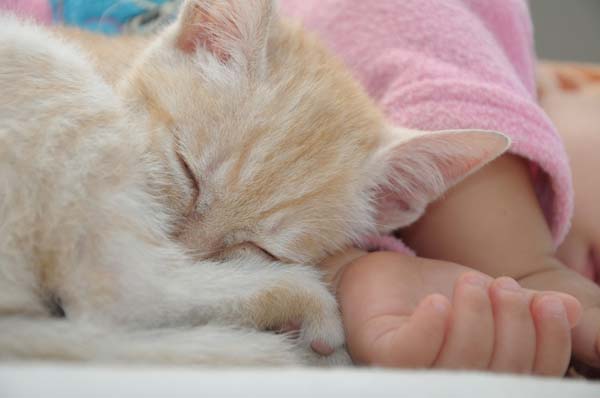Newborn babies are a joy, filling homes with laughter and activity. Although they’re fun, they also bring change to households. Everyone might not be delighted with the lifestyle adjustments that accompany babies. Cats and other resident animals who have never lived with infants may become stressed and have problems adjusting to them. Babies bring change and as a general rule, cats don’t do well with change. Through preparation, patience and work, cats can adjust with a minimum of stress to new babies. Here are six things to do to when you introduce a cat to a baby:

1. Desensitize cats to baby cries
Babies crying startle and stress everyone, including cats. It isn’t a coincidence that babies’ cries sound like animals who are distressed. Newborns and infants are very vulnerable — their survival depends on their mums and other caring adults. Loud and startling cries have a universal effect — they get everyone’s attention. Concerned caregivers rush to the baby’s side when they hear the alarming wails. The downside is that the harsh cries stress cats, especially those who have never lived with babies.
Help your cat adjust to the cries by counter-conditioning and desensitizing her to the sounds before the baby is born. Start by finding recordings of new babies crying. There are many videos available on the Internet, including this one that features six minutes of crying.
Play the sound bytes at a very low volume; a few minutes at a time, multiple times a day. At the same time, engage your cat in activities she enjoys such as play, clicker training and cuddles.
After your cat has adjusted to the low-level cries, slightly increase the volume and the length of time that it’s playing. Gradually turn the volume up until the cries are as loud as those of a healthy baby. Depending on the cat, it may take a week or longer until she is comfortable with the crying.

2. Desensitize cats to new baby smells
Scent plays an important role for how kitties relate and orient to their surroundings. Unless they are used to infants, babies smell different to them. Along with infant odors, add lotions, powders and other products onto the list of unknown smells.
Familiarize your cat to the new baby smells before baby comes home. It’s easy to do. Every day, rub your hands with a small amount of the baby’s lotion or sprinkle a little baby powder on them. Encourage your kitty to smell the new scents by holding your fingers in a position that allows her to approach them for a sniff. If she doesn’t shy from the smell, pet her. If she turns away from you or leaves, put less baby products on.
Families with newborns can help by lending clothes and blankets that their infants wore or were wrapped in. Recently worn items work best because the scents are fresh. Playing around the baby-scented items, grooming, and doing other activities your cat enjoys will help her adjust to the new smells.

3. Create baby-free zones for your cat
Kitties need places where they will feel safe — above little hands, startling movements, and cries. High places to climb, and baby gates with little pet doors are good safety-zone solutions.
Place vertical territory, such as shelves and tall cat trees, in the shared areas. Ideally, vertical territory should be at least five feet tall. These safe zones help felines feel secure while they are hanging out with the whole family. Additionally, when baby starts crawling, increase the safety zones with baby/pet gates.

4. Involve your cat when preparing your home for the new baby
Most expectant parents prepare their homes long before babies are born. Nurseries are set up with cribs, changing tables and other baby furniture. Homes are usually substantially modified in order to accommodate babies. Many cats do not react well to the changes and become stressed.
You can help your cat adjust by involving her in the early preparations. Encourage her to play in the nursery. Also clicker train and have quality cuddle time with your favorite feline while you ready your home. If your cat loves being groomed, spend a little extra time grooming her in the new nursery. Additionally, help her accept new furniture by gently petting her cheeks with a soft towel or sock and then rubbing the sock on the furniture. She will recognize her own scent and feel more relaxed.
If you are keeping your kitty out of the nursery, she can still be part of the action. Remove the door to the room and replace it with a screen door. Additionally, check out crib tents. They keep toddlers and babies from falling out, while discouraging cats from jumping in.
5. How to introduce your baby to your cat
As soon as the baby is born, introduce the cat to the newcomer’s special scent. Designate a family member or friend as the official social facilitator who will initiate the introductions before the baby comes home. Towels and clothes, saturated with the newborn’s scent, are brought home and placed near the cat. When the cat is next to the new-baby-scented items she needs to be stroked, cuddled and engaged in activities she enjoys.
Choose a quiet time, such as the afternoon, when everyone is relaxed for the first baby-to-cat introductions. Pet the cat’s cheek with a soft towel and rub the baby’s feet with the towel. The cat doesn’t need to be held. As she feels more secure, she’ll be curious to meet the newcomer and approach the baby. Encourage her to smell the newborn’s feet and hands. Always supervise interactions between the cat and the baby.
6. Don’t ignore your cat now that your baby is here
Although naturally everyone will be focused on the baby, don’t forget the cat. She is an important part of the family, needing attention and love from her family. Everyone in the household can be recruited to interact with her every day. Clicker training will also help her feel special. Make sure to leave time for those special cuddles and lap-naps as well.

Give yourself and your cat plenty of time to prepare for the new baby. Preparations can start months before the baby is born. Laying the groundwork early will make it easier for the cat to adjust with minimal stress to the newborn baby.
What are your tips for how to introduce a cat to a baby? Tell us in the comments!
Read more on cats and babies on Catster.com:








